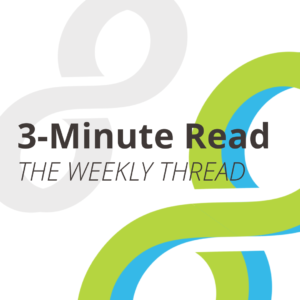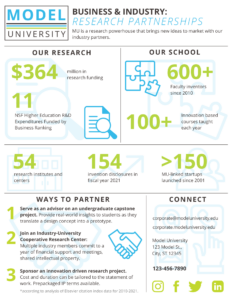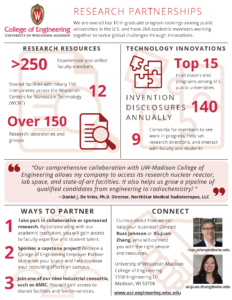Showcasing Research Strengths with Capability Statements
May 15, 2023 — Many universities are keen to partner with industry for research, but “universities” don’t partner; their people do. Unfortunately, it’s not always easy to identify the right university partner from an institution’s website or promotional publications.
Two effective, industry-facing research website examples are Carnegie Mellon University and Penn State University. They set the tone for engagement and make it simple to identify research partnership strengths.
But too often, a university’s online information is densely packed and (understandably) geared to their primary audience—students (and their parents). Although it’s not unusual for a university website to have a “research” section, the pages are often filled with jargon and written for faculty or students. They may lack corporate engagement staff contact information or an easy way to start a more focused conversation.
The same text-heavy, densely-packed pattern holds true for many of the print materials produced by universities for potential industry partners. Wading through too much information can drastically slow down the partnership process. At worst, universities can lose strategic opportunities before even speaking with a potential partner.
To communicate research and program strengths effectively, universities should take a page from the consumer product marketing handbook and showcase unique differentiators—the faculty, facilities, existing centers/institutes, other business-facing programs, or even contracting approaches that make your institution an attractive partner.
That’s where effective and well-thought-out capability statements can have an impact. These concise documents provide critical information, including an overview of the institution’s specific strengths and expertise, unique facilities, and contact information. They serve to both attract and inform potential partners. Capability statements have the capacity to streamline and enhance the way partners find and communicate with each other.
Industry interests first
Helping potential partners quickly assess whether their needs align with the other party’s capabilities can help reduce the time it takes to facilitate a partnership. Capability statements also help industry partners do efficiently triage potential partners, identify universities and programs for future areas of collaboration, and discover areas they may not have considered in the past.
Capability statements can also highlight past successes, illustrating not only the universities’ research capabilities but also the ability to see partnerships through. It’s an effective means to seed trust between potential partners and establish the foundation for partnership.
Crafting a quality capability statement doesn’t have to be a daunting task. Effective ones are brief and should include discrete categories of information.
Based on information shared by our industry members, UIDP has developed a quick guide and two templates to distill the essence of what should be included in a capability statement. The quick guide, Communicating University Research Strengths to Industry Partners, walks through the key content areas to effectively tell the research story. Capability statements can be powerful tools when used in conjunction with an effective research website. The quick guide offers guidance for showcasing research strengths in this electronic format as well.
Not every campus has a marketing team or funding for creative development, so UIDP took the project a step further and created two completely customizable template designs to include an institution’s own data, logos, colors, and text. Both the templates and the quick guide are publicly available, so anyone can use them.
As these new tools were released, we quickly discovered that an individual college or research center within large research institutions would find them helpful to showcase particular strengths. A great example comes from Monyka Lee, student assistant at the University of Wisconsin-Madison’s college of engineering office of corporate relations. Monyka is majoring in marketing (and Chinese) and created the impressive example shown below alongside the original “Model University” design template. She said it best:
“The capability statement for the University of Wisconsin-Madison College of Engineering turned out great! I found the Canva template and the “Communicating University Research Strengths to Industry Partners Quick Guide” on your website extremely helpful and useful. The graphics are eye-catching, and we really liked the facts and statistics in the ‘Our Research’ and ‘Our Values’ because it shows quantitative qualities of UW’s College of Engineering.”
Why it matters
Concise, well-developed capability statements and an effective research website can set a university apart. They facilitate communication, enable informed decision-making, and just make it easier to start conversations about research collaboration.
We hope you’ll take a look at these publicly available tools and put them to work! We also want to hear from you. How does your institution use capability statements? Let us know on our LinkedIn profile.





